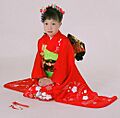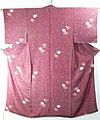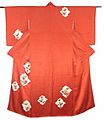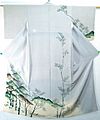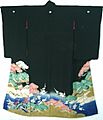Kimono facts for kids
Quick facts for kids Kimono |
|||||
|---|---|---|---|---|---|

Woman wearing traditional Kimono
|
|||||
| Japanese name | |||||
| Kanji | 着物 | ||||
|
|||||
A kimono (着物) is a traditional Japanese garment. The word "kimono" originally meant "something you wear." About 100 years ago, most people in Japan wore kimono every day. Today, people usually wear other types of clothes. However, they still wear kimono for special events like formal parties, or just for fun and fashion.
A kimono is a robe shaped like the letter "T". Most kimono reach down to the ankles and have long sleeves. Some women's kimono have sleeves that also reach the ankles, but most sleeves reach the hips.
Contents
History of Kimono
Japanese people have worn clothes similar to the kimono for many hundreds of years.
Early Kimono Styles
The first kimono-like clothes came to Japan from Chinese visitors during the Kofun period. These clothes had long, triangle-shaped sleeves. People wrapped them around their bodies. They also wore a jacket and a skirt or trousers over them.
A few centuries later, in the Heian period, these clothes changed. They started to look more like modern kimono. The garment became more like a rectangle, and the sleeves were square instead of triangle-shaped.
Kosode and Layers
Most common people wore a garment called a kosode. This name means "short sleeve." This clothing looked like a modern kimono. It had a wider body and smaller sleeves. The front part that overlapped was longer, the collar was wider, and the robe was shorter.
Rich people also wore kosode. But they wore many layers of clothes on top of it. Noble women wore clothing called jūni hitoe, which means "twelve layers." Even though it was called "twelve layers," the actual number of robes could be different. These robes were wider, longer, and had bigger sleeves than the kosode worn by common people. They could weigh up to 20 kilograms (about 44 pounds)! Noblemen wore jackets with round necks, wide, long sleeves, and hakama trousers. They would wear this with a small, usually black, cap.
Changes in Fashion
Over time, wearing so many layers became old-fashioned. The government even made rules to stop people from wearing too many robes at once. Starting in the Muromachi period, both women and men began to wear the kosode by itself. Sometimes they wore it with just two or three layers. They used a small, thin belt called an obi. Women also wore red hakama trousers. However, special clothes for ceremonies in the Imperial Court still looked like the older styles. Even today, the new Emperor and Empress of Japan are crowned in Heian period clothing.
During the Genroku period, common people, especially merchants, started to become richer. This meant people could buy expensive and beautiful kosode, even if they were not noble. People began to try new ways to decorate their clothes, like using embroidery. They also experimented with different ways of dyeing their clothing.
These fancy clothes made common people look like nobles. So, the government made laws to stop commoners from wearing certain things. But people still wanted beautiful clothes! They found different ways to wear them. For example, a man might wear a haori jacket made of plain wool, but line it with a fancy silk fabric inside.
This way of thinking about clothes and how they looked became known as an aesthetic idea called iki. This idea is still important in how people wear kimono today.
Modern Kimono Shape
Over time, the obi belts became wider and longer, especially for women. Because of this, the sleeves of the kosode were no longer fully sewn to the body. For women, they were only attached at the shoulder.
Sleeves also got longer for young women. The length of the kosode also grew longer. This garment started to be called the kimono sometime in the Edo period. The kimono would trail on the floor indoors. But people had to pull it up when going outside so it wouldn't get dirty. Women started tucking the extra length of their kimono into a fold at the hip. This fold became known as the ohashori. Women still wear kimono today with the ohashori.
Later, very wide obi and very long kimono went out of style. During World War Two, long kimono sleeves were seen as wasteful. So, sleeves on kimono were usually shortened, sometimes a lot. This new, shorter sleeve length stayed popular. Modern kimono for women are still shorter than they were before the war. Older kimono, especially from the Taishō period, sometimes still have these longer sleeves.
Today, more women wear kimono than men. Men wear kimono most often at weddings and Japanese tea ceremonies.
Kimono for Men and Women
Kimono are made in different sizes for different people. They are also made in different lengths for men and women. Men and women also wear kimono with different sleeve styles.
Women's Kimono
Kimono for women are much longer than kimono for men. Women fold the kimono at the waist in a tuck to make it the right size. This fold is called the ohashori. The right length for a woman's kimono is usually about the same as her height. However, very tall people might find it hard to find kimono that fit them.
The sleeves on a woman's kimono are not sewn to the body all the way down. They are open at the back. Part of the kimono's body is also open. The sleeves on a woman's kimono are longer than those on a man's kimono. For young women, some sleeves can even reach the ankle. The curve at the edge of the sleeves is very round, especially for young women and girls.
Men's Kimono
Kimono for men do not need to be folded at the hip. So, they do not have any extra length. The sleeves are shorter and are attached almost all the way down to the body. The back of the sleeves is sewn shut, and the body is also sewn shut. The curve at the edge of the sleeve is not as round as on women's kimono.
Kimono for men are usually one solid color. They might have a very small geometric design. Kimono for women can be one solid color, have a small design, or be decorated with larger, colorful patterns. The most colorful kimono are usually worn by young women. Sometimes, these designs are only worn during certain seasons of the year.
People who are very tall or very heavy can find it hard to find kimono that fit them. Sometimes, they have kimono custom-made for them.
Types of Kimono
Kimono come in different types for different events. Both men and women have formal and casual kimono. Formal kimono have special family symbols called kamon or mon. These symbols are placed on the front of the shoulders, the back of the sleeves, and the center of the back. Kimono with crests have either one, three, or five crests. The crests can be just an outline or fully colored in white. An outlined crest is the least formal.
Kimono Materials
Kimono are usually made of silk. But you can also find kimono made of cotton, polyester, hemp, and linen. Some kimono are also made of wool or rayon. Formal kimono are always made from fine silk and are usually sewn by hand. However, not all silk kimono are formal. Some types of silk, like pongee (called tsumugi), are only worn for casual events.
Casual Kimono
The most informal type of kimono is the yukata. People wear yukata in summer for festivals and in bath houses or inns. Both men and women wear them. Yukata are not lined and are always made of cotton. They are worn with thin, brightly-colored obi.
Formal Kimono for Men
For formal events, men wear fine silk kimono with a haori (a kimono jacket) and hakama (loose-fitting trousers). The hakama are usually striped in white and black. The kimono and the haori will match in color.
Formal Kimono for Women
Women have many different types of kimono for formal events. The designs on the kimono, how they are put on, and where they are placed all change how formal the outfit is. Here are some types, from least formal to most formal:
- Komon - A kimono with one pattern that repeats all over. The pattern does not line up perfectly along the seams. It can be small or very large.
- Edo komon - A komon with a very, very tiny pattern repeating all over. It's usually white on a colored background. From far away, these kimono look like one solid color.
- Iromuji - A kimono in one solid color. Iromuji might also have a very soft, dappled design. They are worn for Japanese tea ceremony and other semi-formal events. They may have one or three crests.
- Tsukesage - A kimono with a design along the bottom hem, the back of the right sleeve, and the front of the left sleeve. The designs usually do not match up along the seams, but sometimes they do. The designs are smaller than those on a hōmongi. They are dyed onto the fabric before the kimono is sewn. They may have up to three crests.
- Hōmongi - A kimono with a design along the bottom hem, the back of the right sleeve, and the front of the left sleeve. The designs should match up and cross over the seams. This is because hōmongi are roughly sewn, then the designs are drawn on, then taken apart and dyed. The designs are usually larger than those on a tsukesage. They may have up to three crests.
- Irotomesode - This means "colorful short sleeve." Irotomesode are colorful kimono with a design along the hem. The design is either higher on the left side than the right, or placed on both front overlapping panels (called okumi). An irotomesode can have between one and five crests, but usually has three.
- Kurotomesode - This is an irotomesode with a black background. These are the most formal kimono for women who are not young enough to wear furisode.
- Furisode - This means "swinging sleeve." Furisode are formal kimono for young women. They have bright, large designs all over. They have between one and five crests.
Accessories
People wear a wide belt called an obi with their kimono. Obi are also colorful and very long. Some types of obi are not worn much anymore because they are too hard to wear and tie. The maru obi is an example of an obi that is not worn often now. The fukuro obi replaced it because it was less wide and easier to wear.
Cost of Kimono
Kimono can be very expensive. A brand new woman's kimono can cost more than US$10,000. The obi belts can also be very expensive, costing thousands of dollars. However, most people own kimono that are not so expensive. Some people make their own kimono, or buy them second-hand.
Other Kimono Styles
People who play some sports like kendo also wear kimono. These are tough, thick, and short. They are not like typical women's kimono. They are usually called do-gi.
Wearing Kimono
Most Japanese people do not know how to put on a kimono by themselves. It is very different from other clothing. Formal kimono for women can be very difficult to put on alone. Some people work as "kimono dressers." They help people put on their kimono.
In Japan, people can take classes to learn how to wear kimono. They also learn how to choose kimono and how to tie the obi.
Related pages
Images for kids
-
Woman in kimono at Fukuoka City Hall
-
The overall shape of the kimono changed during the Edo period because of how the obi, sleeves, and layered kimono styles developed. (Utagawa Kuniyoshi, Plum Blossoms at Night, woodblock print, 19th century)
-
This modern yukata is machine-dyed with a nadeshiko pattern, a September flower.
-
Patchwork haori for tea ceremony (chabaori), around 1800; areas likely to be damaged are made in another color. Paper and silk.
-
An uchikake (formal over-kimono) depicting cranes, from the Khalili Collection of Kimono
-
Women's dress influenced by Goguryeo, with an overlapping collar and mo skirt. (Takamatsuzuka Tomb, 7th century)
-
Asuka (late Yamato Period) dress, 7th century
-
Nara-period dress, late 8th century, 2005 reconstruction
-
In the late Heian period, the jūnihitoe had many layers (hitoe) worn over a plain kosode and hakama. (The Tale of Genji, 12th century)
See also
 In Spanish: Kimono para niños
In Spanish: Kimono para niños






